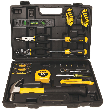There are times when we find ourselves needing to not only repair a sidewalk, but having to replace the entire thing. Pouring a new sidewalk, though somewhat physically strenuous, isn't that hard of a job to do. Be prepared to do some hard work, but follow these simple instructions and you can get the job done.
Materials:
- 7 pound-sledgehammer (optional)
- Jackhammer (optional)
- 3-pound sledgehammer
- Garden rake
- 4-foot level
- 2" x 4" x 6" stakes
- 2"x form stock cut to length
- Wire mesh
- Wire supports
- Concrete
- Concrete bonding agent
- Gravel
- Wheelbarrow
- Staples
- Staple gun
- Metal or wooden float
- Shovel
- Plastic drop cloth
Procedure:
- Remove old concrete. In order to begin pouring a new sidewalk, you will need to remove the old one. This entails you breaking up all of the concrete on the damaged section of the sidewalk using either a sledgehammer or a jackhammer. While it is slightly easier to use a jackhammer, it is still physically exhausting work. Clean up the broken concrete as you break it up, and dispose of it properly. Pick up all of the old concrete, and do not leave any of it behind.
- Create guide forms. Using the old sidewalk as a guide, begin installing some guides and forms for the concrete to stay within. This will help to form the shape of the sidewalk, and ensure that you do not have a large puddle of concrete. Install some 2 inch by 4 inch by 6 inch stakes at each of the corners of the walkway, and then have the form boards rest against the stakes. If it helps to hold them in place, nail the form boards to the stakes. Ensure that everything is straight by using a 4-foot level.
- Lay gravel base. Lay a gravel base inside of the guide forms, and spread it around. Make sure that the gravel is as evenly distributed as possible. Rake the gravel smooth with a regular garden rake.
- Install mesh support system. Evenly space out some wire support frames along the inside of the framed guides. These supports can be purchased at any home improvement store, and only need to be laid on the ground. Place some wire mesh on top of the supports so that it is about midway down the depth of where the concrete is going to be laid.
- Mix and pour concrete. Place the premixed concrete into a wheelbarrow and follow the directions to make it properly. Typically, all you will need to do is add water, and mix it all together with a shovel. Continue to mix the concrete until it has a firm, yet still workable consistency, and then begin to pour the concrete within the forms. The easiest way is to dump the concrete into the forms out of the wheelbarrow, or you can simply shovel it into place.
- Screed and smooth concrete. Roughly level out the concrete by using a 2 inch by 4 inch piece of wood that is long enough to expand the entire width of the forms. Pull this along the side walk, and the concrete will be roughly evened out. Use a metal or wood float and then continue to smooth the concrete out. Once smoothed out, place a plastic drop cloth over the sidewalk and allow it to cure for at least one day before using it.
Author Bio
Lee Wyatt
Contributor of numerous Tips.Net articles, Lee Wyatt is quickly becoming a regular "Jack of all trades." He is currently an independent contractor specializing in writing and editing. Contact him today for all of your writing and editing needs! Click here to contact. Learn more about Lee...
Cleaning Double Paned Windows
Do you happen to have some double paned windows in your home? More than likely you do, since this is a very popular ...
Discover More
Getting Whites White with Front Loaders
Even though front loading washing machines are becoming more popular with the environmentally conscious, they still have ...
Discover More
Moldy Shower Curtains
Shower curtains need to be cleaned periodically just like a shower door does. If this is not done, you can easily find ...
Discover More
More Home Improvement Tips
Installing Gutter Guards
Gutter guards can be a very effective and helpful tool that will not only save your gutters from damage, but also help ...
Discover More
Repairing Vinyl Siding
Vinyl siding is a great option for homes because it is usually more resilient, and lasts longer, than other more ...
Discover More
Installing a Lamppost in Your Yard
Installing a lamppost in your yard can be a great idea for all kinds of reasons. While you can always hire someone to do ...
Discover More

Comments